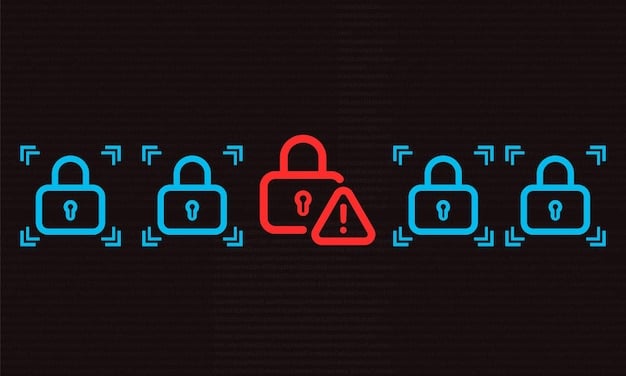US Cybersecurity Regulations: Are Businesses Protected from Breaches?

New cybersecurity regulations are fundamentally reshaping how US businesses must protect sensitive data, mandating more robust defenses and incident response plans to mitigate the escalating threat of data breaches.
In an increasingly digital landscape, the threat of data breaches looms larger than ever, making robust cybersecurity not merely an option but a critical imperative for businesses. With the advent of a wave of new cybersecurity regulations for US businesses: Are you protected against data breaches? This article delves into the evolving regulatory environment, exploring its implications and offering insights into how American enterprises can not only comply but also truly enhance their resilience against sophisticated cyber threats.
the evolving landscape of US cybersecurity regulations
The regulatory framework governing cybersecurity in the United States is dynamic and complex, a reflection of the rapidly evolving threat landscape. Historically, regulations were often industry-specific, like HIPAA for healthcare or Gramm-Leach-Bliley Act (GLBA) for financial services. However, recent years have seen a significant shift towards more comprehensive and cross-sectoral approaches, driven by high-profile breaches and a growing recognition of cybersecurity as a national security and economic stability issue.
This evolving landscape introduces both challenges and opportunities for businesses. Compliance is no longer a check-the-box exercise but requires a deep understanding of multifaceted requirements that can vary significantly state by state, or even across different federal agencies. Businesses must now contend with a patchwork of mandates designed to enhance data protection, incident reporting, and overall cyber hygiene. The goal is to foster a more resilient digital infrastructure capable of withstanding sophisticated attacks that threaten consumer data, intellectual property, and critical national infrastructure.
federal initiatives and their impact
At the federal level, several initiatives are shaping the regulatory environment. The National Institute of Standards and Technology (NIST) Cybersecurity Framework, while voluntary, has become a de facto standard for many organizations, providing a flexible blueprint for managing cybersecurity risks. Beyond guidance, agencies like the Securities and Exchange Commission (SEC) and the Cybersecurity and Infrastructure Security Agency (CISA) are instituting new, mandatory rules. For example, recent SEC rules mandate public companies disclose material cybersecurity incidents within four business days, alongside annual reports on their cybersecurity risk management and governance. CISA, on the other hand, is increasingly focused on critical infrastructure protection, emphasizing information sharing and collaboration.
- SEC Incident Disclosure Rule: Public companies must disclose material cyber incidents within four days.
- CISA’s Role Expansion: Enhanced focus on critical infrastructure protection and voluntary information sharing.
- White House Executive Orders: Directing federal agencies to adopt advanced cybersecurity practices and promoting supply chain security.
These federal mandates underscore a growing governmental insistence on transparency and accountability. The intent is not just to punish non-compliance, but to create a systemic improvement in the nation’s cyber defenses by compelling organizations to prioritize cybersecurity. Businesses failing to adapt risk significant financial penalties, reputational damage, and legal repercussions, making proactive engagement with these regulations essential for sustained operations.
The impact of these federal regulations extends beyond mere compliance; they are forcing a strategic re-evaluation of cybersecurity practices within businesses. Organizations are now more closely scrutinizing their incident response plans, supply chain vulnerabilities, and governance structures. This top-down pressure from regulatory bodies aims to infuse a stronger security culture throughout the enterprise, moving cybersecurity discussions from the IT department to the boardroom.
state-level cybersecurity mandates and variations
While federal regulations provide a broad framework, state-level mandates introduce a layer of complexity and nuance for businesses operating across the United States. Each state can enact its own cybersecurity laws, often tailored to specific industries or data types, leading to a fragmented but increasingly robust regulatory landscape. Understanding these variations is crucial for ensuring comprehensive compliance and avoiding potential legal pitfalls and penalties.
California’s pioneering efforts with the California Consumer Privacy Act (CCPA) and its successor, the California Privacy Rights Act (CPRA), serve as significant examples. These laws grant consumers extensive rights over their personal data, including the right to know what information is collected, to opt-out of its sale, and to request deletion. Businesses falling under CCPA/CPRA jurisdiction must implement robust data protection measures, provide clear privacy notices, and establish mechanisms for handling consumer requests. The financial penalties for non-compliance can be substantial, incentivizing strong adherence.
beyond california: other key state regulations
Other states have followed suit, introducing their own data privacy and cybersecurity laws. Virginia’s Consumer Data Protection Act (CDPA) and Colorado’s Privacy Act (CPA) mirror elements of CCPA, establishing similar consumer rights and business obligations. However, variations exist in scope, definitions, and enforcement mechanisms. For instance, some state laws have different thresholds for applicability based on revenue or the volume of consumer data processed. Furthermore, specific states might have industry-specific regulations, such as New York’s Department of Financial Services (NYDFS) Cybersecurity Regulation, which imposes stringent requirements on financial institutions operating within the state.
- Virginia CDPA & Colorado CPA: Similar consumer rights to CCPA, but with distinct nuances.
- New York SHIELD Act: Broadens existing data breach notification requirements and mandates reasonable security measures.
- Massachusetts Data Security Law: Requires written information security programs for entities handling state residents’ personal information.
The proliferation of these state-specific laws means businesses cannot simply adopt a one-size-fits-all approach to cybersecurity compliance. Instead, a detailed understanding of where personal data is collected, processed, and stored, and which state laws apply, is essential. This often necessitates a dynamic legal and technical strategy, involving regular audits, updated privacy policies, and agile incident response protocols designed to meet diverse regulatory demands.
Navigating this complex web of state regulations requires continuous monitoring and adaptation. Businesses must identify which laws apply to their operations, assess their current compliance posture against each, and implement necessary changes. This often involves investing in data mapping tools, privacy-enhancing technologies, and employee training to ensure that data handling practices align with the specific requirements of every jurisdiction in which they operate.
understanding the definition of a data breach under new regulations
With the surge in cybersecurity regulations, a critical component for businesses is a clear understanding of what constitutes a “data breach” under these new mandates. The definition is not always uniform across all regulations, but generally, it refers to an unauthorized access to or acquisition of sensitive, protected, or confidential data. This unlawful access can lead to the exposure, compromise, loss, or theft of personal information or other proprietary data, triggering notification requirements and potential legal liabilities.
Historically, a data breach might have been narrowly defined, perhaps only requiring notification if “personally identifiable information” (PII) was exposed. However, modern regulations, exemplified by the SEC’s new rules and various state privacy laws, adopt a broader view. They often include a wider range of data types as “sensitive” – from financial account numbers and health records to biometric data and even unique identifiers that, when combined, could identify an individual. The specific threshold for what triggers a breach notification also varies, with some laws requiring substantial harm or risk, while others may demand notification even for minor incidents if unencrypted data is involved.

key elements defining a reportable breach
Several elements typically define a reportable data breach under prevailing US regulations. The unauthorized nature of the access is paramount; accidental internal disclosure, without malicious intent, might not always meet the threshold, though poor internal controls could still lead to fines. The type of data involved is also crucial, with unencrypted personal data often being the trigger for immediate action. Furthermore, many regulations consider the “likelihood of harm” to affected individuals; if the compromised data could realistically lead to identity theft, financial fraud, or other significant issues, notification is almost certainly required.
- Unauthorized Access/Acquisition: The core criterion involving illicit entry or seizure of data.
- Sensitive Data Exposure: Focus on whether PII, financial, health, or other protected data was involved.
- Harm Threshold: Assessment of potential harm to affected individuals, often a key determinant for notification.
Beyond these, new regulations are increasingly emphasizing the “materiality” of a breach, particularly for publicly traded companies. The SEC’s rule, for example, focuses on whether an incident is “material,” meaning it would be important to a reasonable investor. This shifts the focus from simply the technical specifics of the breach to its potential impact on the company’s financial condition, operations, or reputation, requiring a more holistic assessment by leadership, not just legal or IT departments.
Defining a data breach has therefore evolved from a purely technical assessment to one that incorporates legal, ethical, and business impact considerations. Businesses must establish robust internal protocols for assessing potential incidents, engaging legal counsel and cybersecurity experts early, and clearly documenting their decision-making processes. This proactive approach ensures that when an incident occurs, the business can rapidly determine its nature, scope, and whether it meets the definition of a reportable data breach under applicable federal and state laws.
proactive compliance strategies for businesses
In the face of escalating cybersecurity regulations, passive compliance is no longer sufficient. Businesses must adopt proactive strategies that not only meet legal requirements but also build a resilient security posture. This involves a shift from viewing compliance as a burden to recognizing it as an integral part of risk management and business continuity. A robust compliance strategy integrates legal mandates with technical controls, employee training, and ongoing monitoring.
One foundational step is conducting a comprehensive data inventory and mapping exercise. Businesses cannot protect what they do not know they have. This involves identifying all data collected, processed, and stored, classifying its sensitivity, and understanding its flow throughout the organization and with third-party vendors. Such an inventory provides the basis for applying appropriate security controls and determining which regulatory mandates apply to specific data sets.
implementing robust technical and organizational controls
Beyond mapping data, implementing strong technical and organizational controls is paramount. This includes adopting principles like “security by design” and “privacy by design” in the development of new systems and processes. Multi-factor authentication (MFA), regular vulnerability assessments, penetration testing, and robust encryption for data at rest and in transit are no longer best practices; they are increasingly becoming regulatory expectations. Organizations should also invest in advanced threat detection and response capabilities, leveraging AI and machine learning to identify anomalous behavior and potential intrusions much faster than traditional methods.
- Regular Security Audits: Conduct frequent internal and external audits to identify vulnerabilities.
- Employee Training Programs: Implement continuous training on cybersecurity best practices and regulatory requirements.
- Third-Party Risk Management: Vet vendors thoroughly and establish clear data protection clauses in contracts.
Organizational controls extend to establishing clear policies and procedures for data access, incident response, and data retention. A well-defined incident response plan, for example, is not just about technical recovery, but also about fulfilling regulatory notification requirements within prescribed timelines. This demands clear communication channels, designated roles, and regular drills to ensure preparedness. Furthermore, strong vendor management programs are critical, as many data breaches originate from vulnerabilities within the supply chain. Businesses are often held accountable for the security postures of their third-party partners.
Proactive compliance also means fostering a culture of cybersecurity awareness from the top down. Leadership commitment to cybersecurity, adequate resource allocation, and continuous employee education across all levels of the organization are vital. When every employee understands their role in protecting data, the overall security posture improves significantly, transforming compliance from a reactive measure into a strategic advantage.
the critical role of incident response plans
Even with the most robust cybersecurity measures in place, data breaches remain an unfortunate reality. This makes a well-developed and regularly tested incident response plan not just a best practice, but a critical regulatory requirement and a cornerstone of business resilience. New cybersecurity regulations, particularly at the federal level for publicly traded companies and across various state laws, are increasingly focused on the speed and efficacy of an organization’s response to a breach, emphasizing timely notification and thorough investigation.
An effective incident response plan (IRP) extends beyond mere technical recovery. It is a comprehensive roadmap guiding an organization through the entire lifecycle of a security incident, from detection and containment to eradication, recovery, and post-incident analysis. Crucially, modern IRPs must explicitly address the legal and regulatory obligations, outlining who is responsible for assessing materiality, determining notification requirements, and managing communications with affected parties, regulators, and the public. Any delay or misstep in this process can lead to severe fines, legal action, and irreparable damage to reputation.
key components of a robust incident response
A truly robust IRP incorporates several interconnected components. First, it defines clear roles and responsibilities for an incident response team, including IT security, legal, communications, HR, and executive leadership. Second, it establishes precise protocols for detection and analysis, ensuring that potential incidents are identified quickly and their scope accurately assessed. This includes forensic capabilities to understand how the breach occurred and what data was compromised. Third, containment and eradication strategies are critical to prevent further damage and remove the threat from the environment. Fourth, recovery efforts focus on restoring systems and data to normal operations. Finally, post-incident activities, including lessons learned, enable continuous improvement of security measures and the IRP itself.
- Preparation: Develop and document the plan, identify the response team, and define communication strategies.
- Detection & Analysis: Tools and processes for identifying incidents and assessing their scope and impact.
- Containment & Eradication: Steps to limit damage and remove the threat from systems.
- Recovery: Restoring affected systems and data to normal operation securely.
- Post-Incident Review: Analyzing what happened, identifying root causes, and updating security practices.
The regulatory emphasis on timely notification adds another layer of complexity. Many laws specify strict deadlines for reporting breaches – the SEC’s four-business-day rule is a prominent example. Meeting these deadlines requires pre-establishing clear triggers for notification, having pre-approved communication templates, and understanding the specific regulatory bodies or individuals that need to be informed. This often necessitates close collaboration between internal legal teams and external counsel specializing in data privacy and cybersecurity law.
Regular testing and refinement are non-negotiable. Tabletop exercises, simulations, and live drills allow organizations to assess the effectiveness of their IRP, identify weaknesses, and train personnel under realistic scenarios. Without such practice, even a theoretically sound plan may falter under the pressure of a real breach, making the organization vulnerable to both the attack itself and the regulatory repercussions that follow. An incident response plan is therefore a living document, requiring continuous review and adaptation in response to new threats and evolving regulatory demands.
navigating third-party risk and supply chain security
In today’s interconnected business ecosystem, an organization’s cybersecurity posture is only as strong as its weakest link. This critical reality has brought third-party risk and supply chain security to the forefront of new cybersecurity regulations for US businesses. Many recent data breaches have originated not from an organization’s direct networks, but from vulnerabilities within their vendors, contractors, or other third-party service providers who have access to sensitive systems or data. Consequently, regulatory bodies are increasingly holding businesses accountable for the security practices of their entire supply chain.
The implications are profound. Businesses must now extend their due diligence and security oversight far beyond their immediate perimeter. This means re-evaluating relationships with cloud service providers, software vendors, managed service providers, and any other entity that processes, stores, or transmits their data, or interacts with their critical systems. Regulations are pushing for greater transparency and stronger contractual guarantees regarding cybersecurity standards and incident reporting capabilities from third parties.

strengthening third-party cybersecurity management
To effectively navigate third-party risk, businesses need a comprehensive vendor risk management program. This program should begin with meticulous due diligence during the vendor selection process. Thorough security assessments, including asking detailed questions about their security controls, certifications (like ISO 27001 or SOC 2), and incident response capabilities, are essential. It’s not enough to rely on a vendor’s self-assessment; independent audits or security questionnaires bolstered by evidence are becoming standard practice.
- Due Diligence & Vetting: Rigorous security assessments of all potential and existing vendors.
- Contractual Agreements: Include clear cybersecurity clauses, audit rights, and breach notification terms.
- Ongoing Monitoring: Continuously assess vendor security posture and compliance.
Crucially, contractual agreements with third parties must explicitly address cybersecurity. These contracts should outline minimum security standards, data protection responsibilities, compliance with relevant regulations, and clear protocols for breach notification and cooperation during an incident. Granting audit rights to the primary organization allows for periodic verification of the vendor’s security controls. Furthermore, continuous monitoring of third-party security postures is increasingly vital. Automated tools can assess vulnerabilities, track security ratings, and alert businesses to potential risks within their vendor ecosystem, moving beyond one-off assessments to dynamic oversight.
Finally, fostering strong communication and collaboration with third parties is pivotal. Rather than simply enforcing compliance, building partnerships that prioritize shared security goals can lead to more effective risk mitigation. Educating vendors on specific regulatory requirements that impact the primary organization, sharing threat intelligence, and conducting joint incident response drills can significantly reduce the overall risk of supply chain-related data breaches. Businesses cannot afford to outsource their cybersecurity responsibility; they must actively manage the risks inherent in every external relationship.
the road ahead: continuous adaptation and investment
The landscape of cybersecurity regulations in the US is not static; it is a continuously evolving environment driven by technological advancements, emerging cyber threats, and shifting political priorities. For businesses, this signifies that compliance is not a destination but an ongoing journey requiring perpetual vigilance, adaptation, and strategic investment. Resting on past achievements or static security measures will inevitably lead to non-compliance and increased vulnerability to data breaches, undermining trust and operational continuity.
The imperative for continuous adaptation stems from several factors. Cybercriminals are constantly innovating, developing more sophisticated attacks that evade traditional defenses. Regulatory bodies, in turn, respond to these threats by updating existing laws and introducing new ones, often with stricter requirements and heavier penalties. Furthermore, as businesses adopt new technologies like AI, IoT, and cloud computing, new attack surfaces and data handling complexities emerge, necessitating updated security protocols and compliance strategies.
strategic investments for future resilience
To stay ahead, businesses must commit to strategic and sustained investment in cybersecurity. This goes beyond purchasing the latest security software; it encompasses investing in skilled personnel, advanced threat intelligence, and robust processes. Developing an in-house team of cybersecurity experts or engaging reputable external consultants can provide the specialized knowledge needed to navigate complex regulations and implement effective defenses. Continuous training for all employees is also a crucial investment, as human error remains a significant factor in many data breaches. Furthermore, organizations should proactively allocate budget for technologies that offer predictive analytics, automated response, and enhanced data visibility, rather than waiting for a breach to occur.
- Talent Development: Invest in cybersecurity training for existing staff and hire skilled professionals.
- Advanced Technologies: Implement AI/ML-driven security tools for proactive threat detection.
- Regulatory Monitoring: Dedicate resources to track and interpret evolving legal requirements.
Moreover, investment in a culture of security throughout the organization is paramount. This means embedding cybersecurity considerations into every business decision, from product development to marketing campaigns. Leadership must champion security initiatives, demonstrating that it is a core business function, not just an IT problem. Regular communication about cybersecurity risks and best practices can empower employees and foster a collective responsibility for protecting sensitive data. The proactive engagement with evolving regulations, coupled with strategic investments in technology, talent, and culture, will define which businesses not only survive but thrive in an increasingly cyber-threatened world. For US businesses, remaining protected against data breaches hinges on this continuous commitment to evolving their cybersecurity posture in lockstep with the dynamic regulatory and threat landscape.
| Key Point | Brief Description |
|---|---|
| 🛡️ Evolving Regulations | US cybersecurity laws are becoming more comprehensive, moving beyond industry-specific rules to broader mandates. |
| 🚨 Breach Definition & Reporting | Regulations broaden what constitutes a breach and demand swift, transparent notification. |
| 📈 Proactive Compliance | Businesses need strong technical controls, regular audits, and employee training for effective security. |
| 🔗 Third-Party Risk | Managing vendor security is crucial as supply chain vulnerabilities become major breach vectors. |
frequently asked questions about US cybersecurity regulations
▼
Key federal regulations include the SEC’s new rules on cybersecurity incident disclosure for public companies, HIPAA for healthcare, GLBA for financial services, and various CISA guidelines for critical infrastructure. While some are industry-specific, the trend is towards broader mandates impacting all businesses handling sensitive data.
▼
State laws, like CCPA/CPRA in California or those in Virginia and Colorado, often focus on consumer data privacy rights. They can have different applicability thresholds, specific definitions of personal information, and distinct enforcement mechanisms, requiring businesses to adapt compliance strategies to each relevant state.
▼
A data breach typically involves unauthorized access to or acquisition of sensitive data, such as PII, financial, or health information. Modern regulations often broaden the scope of “sensitive data” and may require notification based on the likelihood of harm or the materiality of the incident, even for unencrypted data.
▼
New regulations mandate swift and transparent breach notification within strict deadlines. A robust IRP ensures quick detection, containment, and recovery, while also outlining legal and communication protocols to meet these regulatory obligations, mitigating financial penalties and reputational damage.
▼
Regulations increasingly hold businesses accountable for the security posture of their supply chain. This means requiring rigorous due diligence, strong contractual clauses with vendors regarding data protection and breach notification, and ongoing monitoring of third-party security practices to mitigate widespread risks.
conclusion
The landscape of US cybersecurity regulations is undergoing a profound transformation, moving towards more stringent and comprehensive mandates aimed at bolstering the nation’s digital defenses. For US businesses, this evolving environment underscores a critical truth: protection against data breaches is no longer merely a technical challenge but a strategic imperative intricately linked to regulatory compliance, operational continuity, and market trust. Proactive engagement with these new regulations, coupled with sustained investment in robust security measures, incident response preparedness, and vigilant third-party risk management, will be paramount for any organization seeking to safeguard sensitive information and maintain its competitive edge in the digital age. The time for businesses to truly assess their cybersecurity posture and align it with the demands of an ever-changing regulatory horizon is unequivocally now.





